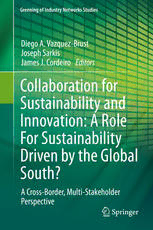
Collaboration for Sustainability and Innovation: A Role For Sustainability Driven by the Global South?: A Cross-Border, Multi-Stakeholder Perspective PDF
Preview Collaboration for Sustainability and Innovation: A Role For Sustainability Driven by the Global South?: A Cross-Border, Multi-Stakeholder Perspective
Greening of Industry Networks Studies Diego A. Vazquez-Brust Joseph Sarkis James J. Cordeiro Editors Collaboration for Sustainability and Innovation: A Role For Sustainability Driven by the Global South? A Cross-Border, Multi-Stakeholder Perspective Collaboration for Sustainability and Innovation: A Role For Sustainability Driven by the Global South? Greening of Industry Networks Studies VOLUME3 SeriesEditors: D.A.Vazquez-Brust JosephSarkis Forfurthervolumes: http://www.springer.com/series/10444 Diego A. Vazquez-Brust • Joseph Sarkis James J. Cordeiro Editors Collaboration for Sustainability and Innovation: A Role For Sustainability Driven by the Global South? A Cross-Border, Multi-Stakeholder Perspective 123 Editors DiegoA.Vazquez-Brust JosephSarkis SchoolofManagement SchoolofBusiness RoyalHollowayUniversityofLondon WorcesterPolytechnicInstitute EghamSurrey,UK Worcester Massachusetts JamesJ.Cordeiro USA StateUniversityofNewYork BrockportCollegeatBrockport Brockport,NY,USA ISBN978-94-007-7632-6 ISBN978-94-007-7633-3(eBook) DOI10.1007/978-94-007-7633-3 SpringerDordrechtHeidelbergNewYorkLondon LibraryofCongressControlNumber:2013954710 ©SpringerScience+BusinessMediaDordrecht2014 Thisworkissubjecttocopyright.AllrightsarereservedbythePublisher,whetherthewholeorpartof thematerialisconcerned,specificallytherightsoftranslation,reprinting,reuseofillustrations,recitation, broadcasting,reproductiononmicrofilmsorinanyotherphysicalway,andtransmissionorinformation storageandretrieval,electronicadaptation,computersoftware,orbysimilarordissimilarmethodology nowknownorhereafterdeveloped.Exemptedfromthislegalreservationarebriefexcerptsinconnection with reviews or scholarly analysis or material supplied specifically for the purpose of being entered and executed on a computer system, for exclusive use by the purchaser of the work. Duplication of this publication or parts thereof is permitted only under the provisions of the Copyright Law of the Publisher’slocation,initscurrentversion,andpermissionforusemustalwaysbeobtainedfromSpringer. PermissionsforusemaybeobtainedthroughRightsLinkattheCopyrightClearanceCenter.Violations areliabletoprosecutionundertherespectiveCopyrightLaw. Theuseofgeneraldescriptivenames,registerednames,trademarks,servicemarks,etc.inthispublication doesnotimply,evenintheabsenceofaspecificstatement,thatsuchnamesareexemptfromtherelevant protectivelawsandregulationsandthereforefreeforgeneraluse. While the advice and information in this book are believed to be true and accurate at the date of publication,neithertheauthorsnortheeditorsnorthepublishercanacceptanylegalresponsibilityfor anyerrorsoromissionsthatmaybemade.Thepublishermakesnowarranty,expressorimplied,with respecttothematerialcontainedherein. Printedonacid-freepaper SpringerispartofSpringerScience+BusinessMedia(www.springer.com) Foreword There is a quotation attributed to Albert Einstein that frequently surfaces during debates about sustainability along the lines of “The significant problems we face today cannot be solved through the same type of thinking that we employed when we created them.” The statement represents a paraphrasing and amalgamation of several of Einstein’s comments about education and politics in relation to atomic physics,ratherthanadirectquotation,butthesentimentiscorrect,andtherelevance totoday’sproblemslinkedtosustainabilityisunquestionable. It is in helping us to think differently about how to address some significant problems arising today, and ones that will have consequences for the future, that makes this book both valuable and timely. Technological innovations will be important solving many of the social and environmental problems that we face, butexpectingthetechnologistsalonetodeliverrealprogresstowardssustainability is neither fair nor realistic. An equally important field for innovation is in our thinking, and in how we understand and seek to manage the interrelationship betweeneconomicactivity,socialprogress,andthenaturalenvironment.Creatinga formof“sustainabilityrevolution”inboththe“hardware”and“software”ofsociety isadauntingchallengethatwillrequireawiderangeofstakeholderscontributing, andoftenworkingtogetherinnewcollaborativerelationships. A key component of our established and unsustainable way of thinking is our tendency to artificially divide, delineate, and separate things. This applies in politics and geography where arbitrary lines of governance are imposed over natural landscapes and ecosystems. It applies to the separation of our thinking about business, economics, and finance from the natural resources and ecosys- tems services on which we all ultimately depend. It applies to our division of humanactivityintoseparatespheresthatwelabelascommercialenterprise,social enterprise, public service, and civil society. It even applies to knowledge itself which becomes increasingly specialized and compartmentalized as we subdivide academic disciplines ever more finely. What has become clear over the years is that the boundary-less nature of sustainability as a field of knowledge makes it essentiallymeaninglesstotalkaboutasustainableproduct,asustainablebusiness, v vi Foreword asustainablecity,orasustainablenation(eventhoughyouwillfindbooks,confer- ences,andpoliciesaplentytalkingabouteachofthem).Applyingtheprinciplesof sustainability within the business or policy arenas only becomes truly meaningful whenweenvisagetheseentitiesaspartofbroaderandopensystemsofproduction and consumption, of living, or of governance. Such systems almost inevitably cross international borders. Therefore cross-border collaborative relationships that bring together stakeholders to develop innovative social and technical solutions to sustainabilityproblemsrepresentavitallyimportantplankwithwhichtobridgethe gapbetweenourunsustainablepresentandourvisionofamoresustainablefuture. It remains however an academically underexplored field, perhaps because it does neatly fit into any one of our preexisting disciplinary-based notions of innovation anddevelopment. Thebeautyofthisbookliesinitschallengetousasreaderstothinkdifferently about the boundaries, the relationships, and the stakeholders involved in cross- bordercollaborationsaimedatgeneratingsustainableinnovation.Afutureinwhich financial wealth flows across the (also arbitrary) north–south divide from richer to poorer countries will be vital for the relief of poverty and the pursuit of sustainability. However, if this is achieved through the gradual liquidation of the natural wealth of poorer countries in order to maintain the global economic status quo, neither poverty reduction nor sustainability will ultimately be achieved. The result instead will be a natural capital “crunch” that will make the global credit crunch experienced in the aftermath of 2008 look inconsequential by comparison. The key to success will be to find new ways of generating social and economic valuefromthesocialandenvironmentalcapitalthatexists,withoutitserosion.This will require a tremendous amount of innovative thinking in government policies, inbusinessmodelswithinkeyindustries,intechnologicaldevelopment,inhowwe measureprogressandwealth,andinhowwestructure,manage,evaluate,andlearn fromcross-bordercollaborations. Todateourunderstandingofthewaythatinnovativethinkingandrelationships can contribute to substantive progress in international development has tended to be long on interesting examples of good (and bad) practice, but short on rigorous andcoherenttheorybuilding.ByadoptingatransdisciplinarySustainabilityScience approach and applying both a multi-stakeholder and a multilevel perspective, this bookofferstheinstitutionsandindividualsinvolvedincross-bordercollaborations theopportunitytofullyappreciatetheirdynamicsandpotential.Itschaptersprovide awealthofinsightsfromdifferenttheoreticalperspectivesillustratedwithexamples drawnfromdifferentcountriesandhighlightingtherangeoftypesofcollaborative relationshipsthatareemerging. This book’s publication also coincides with a significant downturn in the level of aid for international development that most of the major OECD countries are willing to provide. As the conventional “donor driven” model of international developmentcomesunderbothfinancialpressureandincreasinglycriticalanalysis intermsofitseffectiveness,thereisgrowinginterestinalternatives.Oldboundaries are blurring, and past certainties about sources of knowledge and leadership in Foreword vii the search for pathways to sustainability are eroding. The time has come to think differently about how we can develop effective collaborative relationships across theboundariesbetweencountries,industries,andsectorsinthesearchforthesocial andtechnologicalinnovationsrequiredtomakesustainabilitysomethingmorethan justanaspiration. KenPeattie Contents 1 CollaborationforSustainabilityandInnovationinthe GlobalSouth:ACross-Border,Multi-stakeholderPerspective ....... 1 DiegoA.Vazquez-Brust, JosephSarkis, andJamesJ.Cordeiro 2 ChallengesofCross-BorderCollaboration:Knowledge NetworksforInnovationandSustainabilityintheGlobalSouth..... 25 CeciliaHidalgoandClaudiaE.Natenzon 3 TheRoleofExpatriatesinCross-SubsidiaryCollaboration........... 43 MinoriKusumoto 4 TheRolesofFirstandSecondTierSuppliersinGreening InternationalSupplyChains .............................................. 63 Chao-MinLiu,DiegoA.Vazquez-Brust,andJosephSarkis 5 Cross-Border Innovation in South–North Fair Trade Supply Chains: The Opportunities and Problems of Integrating Fair Trade Governance into Northern PublicProcurement ........................................................ 87 AlastairM.Smith 6 Transboundary Conservation Through Hybrid Partnerships:AComparativeAnalysisofForestProjects............. 107 SaleemH.Ali 7 Multi-stakeholderInternationalGovernanceInitiatives: AddressingtheChallengesofASMSectorinGhana................... 127 NataliaYakovlevaandDiegoA.Vazquez-Brust 8 Implementing a Developing Country’s Global Environmental Commitments: Industry Perspectives onPotentialPollutionPreventionProgramsinBangladesh........... 149 AsadulHoque,AmeliaClarke,andAdrianeMacDonald ix
